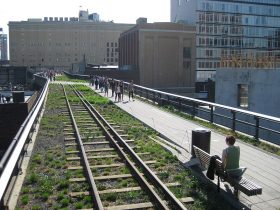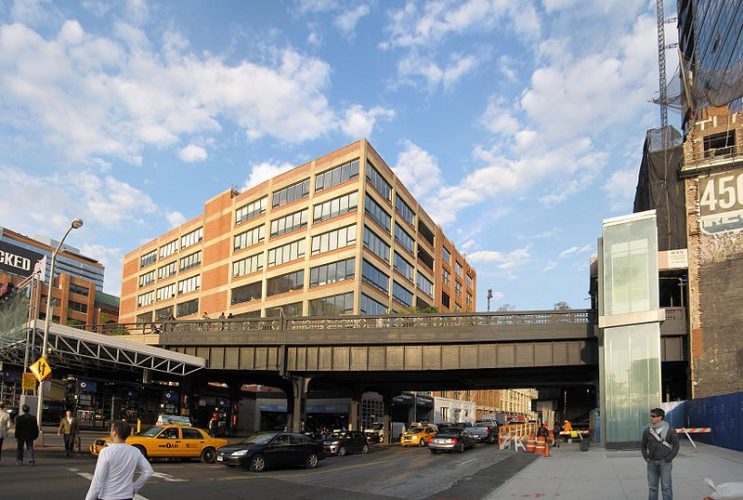The history of the High Line is as long and winding as the current path, which cuts through the West Side of New York City, along 10th Avenue, where it ultimately terminates at Hudson Yards. The High Line has not always been a public park space, filled with artwork, tourists, and food vendors. Constructed thirty feet above the ground, the High Line offers unique views both into the Hudson River as well as the bustling streets of New York. Once a railway line, the space fell into disrepair and then was the subject of a fervent revitalization effort in the 1980s. The park, as it now stands, was completed in 2009. Through its history as a railway line, a space for art, as a subject of revitalization, and as a park, the High Line has represented the evolving nature of New York City.
Originally, the High Line served as a rail line starting in the mid-1930s until 1980 when it was known simply as the “West Side Elevated Line.”[1] Originally, the path of the now-elevated tracks was on the ground and cut through 10th Avenue. It served to connect the Western Electric factory with lines that brought the freight needed for the assembly of various products in the facility.[2] Elevated tracks had become a necessity as pedestrians were continuously hit and killed by trains in the neighborhood, with 10th Avenue even receiving the moniker “Death Avenue.”[3] Seeing this need, the decision was made to raise the tracks into what is now known as the High Line in 1929. The West Side Elevated Line even cut through existing buildings, “in 1931 Bell Laboratories had to partition off space in its building between the second and fifth floors to make way.”[4] The use of the West Side Elevated Line declined after World War II due to the shift to trucking instead of rail to transport goods around the city.[5] By 1970, part of the line had closed at Bank Street and by 1980, use of the rest of the line had halted.[6]
After the line fell into disuse, greenery overtook the tracks while the actual structure succumbed to rust and abandonment. A New York Times article 2000 describes it, “With no boxcars to screech over the rusting tracks and frozen switches, the 30-foot-wide elevated structure has been colonized by chest-high grasses…”[7] Overrun and unmaintained, the High Line was seen by many as a nuisance and a structure meant for demolition multiple times over. In images captured by photographer Joel Sternfeld, the High Line became occupied by vagrants and artists alike.[8] It remained in this state until 2009, when a revitalization group succeeded in its goal to convert the old line into a park. In fact, were two concerted efforts to repurpose or revitalize the High Line, with Peter Obletz taking the initial, unsuccessful step towards repurposing the structure and the Friends of the High Line group being the second and evidently successful group.
Peter Obletz served as the face of the original plan to reinvest in the crumbling infrastructure of the rail line in Hell’s Kitchen. A resident of the neighborhood and an intense, self-proclaimed train enthusiast, Obletz sought to save what was a crumbling rail line and turn it into a new passenger train line for the West Side.[9] He was active in community action, serving on his community’s board, the transportation committee, and working with the Metropolitan Transportation Authority (MTA).[10] Obletz eventually bought the line in 1984 for a mere $10 and created the West Side Rail Line Development Foundation to begin work to set up the passenger rail line.[11],[12] The purchase soon embroiled him in a legal battle with New York’s Department of Transportation as well as surrounding neighbors.[13]
Some local Hell’s Kitchen homeowners were not enthusiasts of Peter Obletz’s railway revitalization efforts with the tracks. In a 1984 New York Times letter to the editor, a local homeowner writes about the tracks in disrepair, “…in our view, there is nothing desirable about them.”[14] The letter continues that the main problem with the railway project is that there will be “accompanying noise and pollution.”[15] It concludes by saying that the best option for the railway line is demotion.[16] Luckily for the dissatisfied homeowners the Department of Transportation overturned the sale of the line by the holding company Conrail to Obletz in 1987.[17] While Peter Obletz was never able to realize his dream of turning the old rail line into a new transportation project, many credit him with preventing its demolition in the 1980s.
The next group to try and revitalize the rusting behemoth was formed by Joshua David and Robert Hammond. Interestingly, the duo did not know of Peter Obletz until after his death.[18] David was quoted by the New York Times about Obletz and his own journey saying, “There is something poetic and moving about following in the footsteps of someone you never knew who was passionate about some of the same things you are.”[19] The duo dubbed their group, founded in 1999, Friends of the High Line and equally set about refurbishing the line.[20] Unlike Obletz, however, the group was interested in converting the line into a park rather than into a passenger rail line.
The efforts of the Friends of the High Line did not immediately pay off. In 2005, the area was rezoned to be able to be used as a park and the project continued to move forward.[21] The New York Times headline about the news read, “A Frog of a Rail Line Is Set to Become a Prince of a Park.”[22] Construction began soon after with the park finally unveiling to the public in 2009.[23] The initial iteration of the High Line ran from Gansevoort Street to 20th Street.[24] The next section, which opened in 2011, ran from 20th Street to 30th Street.[25] The third completed section opened three years later in 2014 and ran from 30th Street to 34th Street.[26] In total, the current High Line is 1.45 miles long and is utilized as a public, free park space with art installations and food vendors dotted along the lengthy path.[27]
As the High Line is an extremely unique piece of architecture, as a rail line that has been converted to an elevated park, work has been done to analyze the standpoint of this cultural phenomenon in the context of New York City and the world. One key question that has been raised in regard to the High Line is the idea of gentrification.[28] Deconstructing the High Line refers to the park as “one of the city’s most popular tourist attractions and an anchor for the super-gentrification of western Chelsea.”[29] Indeed, if one visits the High Line today, the neighborhood is very different from the one of Peter Obletz’s time. Another idea that has been explored is how the High Line fits into the green space of New York City.[30] Both lenses have been used to analyze the High Line. Ultimately, the free nature of the High Line and its conversion into a public space from its derelict beginnings has been praised. Cities around the world have tried to replicate the success of the High Line and it serves as a cultural and urban monument to transformation and efficient use of past for the present.
The history of the High Line serves to tell the story of New York City in a broader sense. Originally used as a train line, representing New York’s importance as a shipping hub, it fell into disrepair in the 1980s and was often used by the homeless or underground arts scene. It was eventually renovated as a public art and park space in the 2000s. By exploring the High Line, one can then understand greater themes of New York City’s history. As the High Line has been refurbished from its derelict past, it pulls in the memory of the shipping use throughout the walkable line. Users of the High Line feel as if they are fully immersed in the many stories of New York City. As they walk down the line they can see the old tracks cutting alongside the path. Stretching over bustling streets, one feels they can watch the hustle and bustle of New York life from a bird’s eye view and turn to see into the Hudson. The High Line truly serves to encapsulate New York City, its past and present and its serenity and speed.

[1] “History,” The High Line, accessed March 29, 2020, https://www.thehighline.org/history/.
[2] Christopher Gray, “As High Line Park Rises, a Time Capsule Remains,” New York Times, 2008.
[3] “History.”
[4] Gray, “As High Line Park Rises, a Time Capsule Remains.”
[5] Gray.
[6] Gray.
[7] David Dunlap, “Which Track for the High Line?,” New York Times, 2000, ProQuest, https://search.proquest.com/hnpnewyorktimes/docview/91565675/E5E3060B291C43B4PQ/1?accountid=13793.
[8] Joel Sternfeld, Adam Gopnik, and John Stilgoe, Walking the High Line (Steidl, 2001).
[9] John Gill, “The Charming Gadfly Who Saved the High Line,” New York Times, 2007, sec. The City.
[10] James Barron, “Peter E. Obletz, 50, a Lover of Old Trains, Dies,” New York Times, 1996, sec. OBITUARIES.
[11] Gill, “The Charming Gadfly Who Saved the High Line.”
[12] Barron, “Peter E. Obletz, 50, a Lover of Old Trains, Dies.”
[13] Gill, “The Charming Gadfly Who Saved the High Line.”
[14] Schoonover and Alan Straus, “Tear Down the Tracks,” New York Times, 1984.
[15] Schoonover and Straus.
[16] Schoonover and Straus.
[17] Gill, “The Charming Gadfly Who Saved the High Line.”
[18] Gill.
[19] Gill.
[20] Gill.
[21] “History.”
[22] “A Frog of a Rail Line Is Set to Become a Prince of a Park,” accessed April 1, 2020, https://query.nytimes.com/gst/fullpage.html?res=9A00E3DE163BF936A25755C0A9639C8B63.
[23] “History.”
[24] “Design,” The High Line, accessed April 1, 2020, https://www.thehighline.org/design/.
[25] “Design.”
[26] “Design.”
[27] “History.”
[28] Christoph Lindner and Brian Rosa, Deconstructing the High Line : Postindustrial Urbanism and the Rise of the Elevated Park (Rutgers University Press, 2017).
[29] Lindner and Rosa.
[30] Kevin Loughran, “Imbricated Spaces: The High Line, Urban Parks, and the Cultural Meaning of City and Nature,” Sociological Theory 34, no. 4 (2016): 311.

A well written piece! Dream of visiting NYC agaon one day to walk the High Line one day but have make it across the Atlantic first…